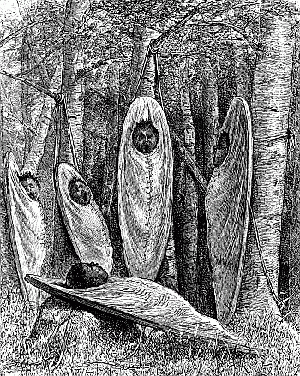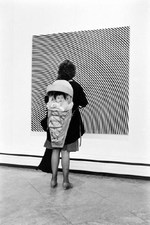
From Henry Wood Elliott, Harper's Magazine, 1878:
The writer in 1870 was taking a short-cut over the country near old Fort Casper, on the Platte, when he paused to kneel and drink at a clear little stream as he crossed. Suddenly his attention was arrested by a succession of queer, cooing, snuffling sounds that caused him to peer curiously about into the recesses of the surrounding birch and poplar thicket, where he discovered to the right and just above him five pappooses slung to the trees, all alone in their glory, amusing themselves by winking and staring at one another, apparently as happy as clams at high water; but, unfortunately for their serentiy, they caught sight of the pale-face, and with one accord they began to howl in dismal and terrified accents, so that in less than a minute six or seven squaws came crashing through the underbrush to the rescue. Happy mothers! It was not, as they feared, a bear, and the tempest was quelled at once.There are no bears, but there is a sweet Bigfoot sighting in Metafilter's nice roundup on cradleboards, traditional American Indian baby carriers, not all of which involved immobilizing the kid's head and flattening her forehead to an aesthetically pleasing point, as William Clark [as in Lewis-&] described in 1806:

"I have observed the heads of many infants," he wrote, "after this singular bandage had been dismissed, or about the age of 10 or eleven months, that were not more than two inches thick about the upper edge of the forehead and reather thiner still higher." The result is a straight line from the top of the head to the end of the nose. This custom, he reported, had been observed among all the Indian nations he had met with west of the Rockies.The engraving up top is just of many great cradleboard images from Elliott's Harper's article, and for the baby backpack aficionado, it's worth the cost of a subscription on its own. The piece is called "Wild Babies," and it reports on the childrearing practices of the savage races who--guess what, are just like us!
A touch of nature makes the whole world kin, so we have chosen a trite illustration of the truth of this statement, and vneture to exhibit it by showing to our parents the manner in which certain savage people treat their offspirng, because a pleasant and envious notion is entertained here and in other civilized precints that young Indians grow--just grow as Topsy thought she did. But it is not so: they have sore eyes and bad tempers; they wake up in the night with lusty yells and the colic; they have fits; they raise riots when cutting their teeth; and they are just as much petted and just as mischievous as our own.The Patterson-Gimlin Bigfoot is actually a cradleboarded Chinook. Discuss. [mefi via jj daddy-o]
"Wild Babies," Nov. 1878 [harpers.org, sub req.]
Previously: Eskimo timeout techniques from "Wild Babies"




My wife sees a fair number of cradleboards in her labor and delivery work, sometimes made by a family member, sometimes made by a group of elders. It depends on the tribe, but ours more closely resemble snug baskets. They remind me of the car seats parents lug into stores, except these are much lighter and seem easy to carry.
[yes, there is some family tradition element to making them, it seems. like those little almost-kachina dolls (?) After seeing so many different designs, I have to think there's a modern gear innovation for us non-tribal types to be found in there, something that doesn't involve headflattening. -ed.]